| Article ID | Journal | Published Year | Pages | File Type |
|---|---|---|---|---|
| 5592621 | Physiological and Molecular Plant Pathology | 2017 | 36 Pages |
Abstract
Verticillium wilt is one of the most severe diseases of olive. In this study, differential physiological and biochemical responses of two olive cultivars differing by their susceptibility to Verticillium dahliae were investigated using gene expression analyses and monitoring of some physiological and biochemical parameters. Results revealed that early up-regulation of SOD gene, together with a reduced scavenging system activity, resulted in higher H2O2 burst in the resistant cultivar as compared to the susceptible one. In addition, early and simultaneous up-regulation of chitinase and β-1,3-glucanase genes is correlated with reduced susceptibility and wilt symptoms in the resistant cultivar Sayali. The expression level of genes coding for PR10 protein, PLD and WRKY transcription factor was higher in the resistant cultivar, which indicates that induction of the SA pathway is essential for conferring resistance against V. dahliae and reduction of wilt symptoms. Furthermore, comparison of the SA-related genes expression patterns with those followed by the H2O2 burst, chitinase and β-1,3-glucanase genes, revealed that high SA level and H2O2 production, together with enhanced PR proteins activity are a key factor for resistance. As JA-related genes, a strong co-up-regulation of jasmonate ZIM domain and bHLH-binding factor responsive to JA was recorded in both cultivars, except that the extent of this induction was higher in the resistant cultivar. Similarly, the ERF related gene was differentially up-regulated in the two cultivars, which suggests that ET may play a role in the enhancement of olive resistance to V. dahliae. Overall, our findings provide important clues for designing strategies to restrict the effects of this disease.
Related Topics
Life Sciences
Agricultural and Biological Sciences
Plant Science
Authors
Yaakoub Gharbi, Mohamed Barkallah, Emna Bouazizi, Radhouane Gdoura, Mohamed Ali Triki,
